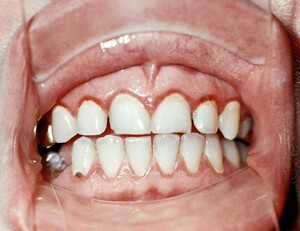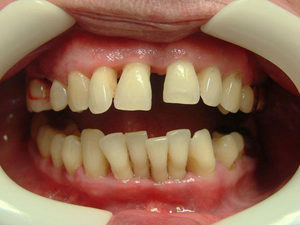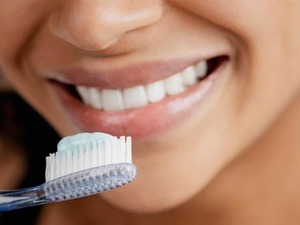What is gingivitis: symptoms, traditional and folk methods of treating this disease, dental advice
 Gingivitis is an inflammatory disease of the gums, manifested by redness, swelling and bleeding.It affects only the mucous membrane, without affecting the dentogingival ligament, so the teeth retain a firm position, because gingivitis is considered an easy gum disease.At an early stage of the onset, gingivitis is easily treated and does not cause much trouble.But, if the process of inflammation is released from control - it becomes chronic, from which it will be much more difficult to get rid of.This disease is most often found in children, adolescents and in persons under thirty.
Gingivitis is an inflammatory disease of the gums, manifested by redness, swelling and bleeding.It affects only the mucous membrane, without affecting the dentogingival ligament, so the teeth retain a firm position, because gingivitis is considered an easy gum disease.At an early stage of the onset, gingivitis is easily treated and does not cause much trouble.But, if the process of inflammation is released from control - it becomes chronic, from which it will be much more difficult to get rid of.This disease is most often found in children, adolescents and in persons under thirty.
If you feel uncomfortable while eating, and when you brush your teeth, you should see a doctor immediately.The development of gingivitis can be associated with diseases such as diabetes mellitus, malignant diseases( cancer), AIDS and hepatitis.






 Professional dentists classify gingivitis as:
Professional dentists classify gingivitis as: - in terms of prevalence: localized when only the gum area becomes inflamed.Generalized when all the mucous membrane of the mouth is inflamed;
- by severity: light, medium and heavy;
- by the nature of the current: acute and chronic;
- in form: catarrhal, ulcerative-necrotic, hypertrophic, atrophic;
- separate group: juvenile, gingivitis of pregnant women.
Why does gingivitis occur?
- Inadequate or poor hygiene of the oral cavity;
- Low level of immunity;
- Low-quality dental treatment: overhanging seals, injuring gums, improper installation of prostheses and braces;
- Accumulation on the teeth of the supragingival and subgingival stone;
- Pregnancy;
- Adolescence;
- The period after the transfer of a severe and prolonged illness;
- Lack of vitamins and trace elements;
- Tuberculosis, AIDS, diabetes, hepatitis and other chronic diseases;
- Gum injuries.






 Professional dentists classify gingivitis as:
Professional dentists classify gingivitis as: - in terms of prevalence: localized when only the gum area becomes inflamed.Generalized when all the mucous membrane of the mouth is inflamed;
- by severity: light, medium and heavy;
- by the nature of the current: acute and chronic;
- in form: catarrhal, ulcerative-necrotic, hypertrophic, atrophic;
- separate group: juvenile, gingivitis of pregnant women.
Why does gingivitis occur?
- Inadequate or poor hygiene of the oral cavity;
- Low level of immunity;
- Low-quality dental treatment: overhanging seals, injuring gums, improper installation of prostheses and braces;
- Accumulation on the teeth of the supragingival and subgingival stone;
- Pregnancy;
- Adolescence;
- The period after the transfer of a severe and prolonged illness;
- Lack of vitamins and trace elements;
- Tuberculosis, AIDS, diabetes, hepatitis and other chronic diseases;
- Gum injuries.
 The main factor in the development of gingivitis is ineffective oral hygiene.The soft plaque remaining after a bad cleansing in the area of contact of the gum with the tooth is gradually transformed into tartar.Here, the actively multiplies the microorganisms , which trigger the process of inflammation of the gums, which is called "gingivitis."
The main factor in the development of gingivitis is ineffective oral hygiene.The soft plaque remaining after a bad cleansing in the area of contact of the gum with the tooth is gradually transformed into tartar.Here, the actively multiplies the microorganisms , which trigger the process of inflammation of the gums, which is called "gingivitis."
The organism reacts to the vital activity of bacteria by an inflammatory process.On the tooth formed a biological film, it is involved in the appearance of a soft plaque.Mineralizing food remains on it and become an incubator for the development of bacteria.They penetrate into the gum and secrete toxins, damage the cells of the mucous membrane.In a place where toxins have penetrated, there is swelling and redness.The distance between the gum and the tooth( gum pocket) expands.Then the gum becomes bleeding.
Symptoms of gingivitis
Symptoms of the disease depend on the shape, nature, prevalence, severity of the oral cavity.
If the degree of severity is high, then bright and active will show reddening and swelling of the gums.Severe form of hyperemia spreads throughout the jaw until inflammation of the mucous lips.
All forms of the disease are characterized by painful sensations when chewing food, bleeding, the appearance of bad breath, unpleasant sensations in the place of inflammation, itching.

Acute gingivitis is accompanied by severe pain and sudden reddening of the gums.The chronic course of is manifested by seasonal exacerbation of , that is, in spring and autumn and is not as pronounced as in acute gingivitis.In the oral cavity, there is discomfort, but it is tolerable, bleeding intensifies.
Each form of gingivitis has a number of specific symptoms, but the common signs are the same, they are usually enough to make a visit to the dentist.A qualified periodontist will be able to establish a diagnosis by the nature of the gum lesion and prescribe the right treatment.
For example, the symptoms of acute catarrhal gingivitis manifest themselves as sudden acute pain, poor health and a fever of 37 degrees.There is swelling, burning, reddening of the gums, eating is difficult, as the inflamed gum reacts to mechanical irritations.In no case can be treated independently by , since in this case the symptoms of the disease are muffled and it passes into the chronic phase.If you consult a doctor, acute gingivitis will pass quickly and without a trace.
Chronic catarrhal gingivitis occurs as a result of the advanced acute stage of the disease.Symptoms are not so bright and only appear during the period of brushing and eating.But such signs as hyperemia and hemorrhage indicate the presence of the disease.With the long course of the disease, an increase in the depth of the gingival pockets is observed, as well as the appearance of a blue gum tint.
Chronic catarrhal gingivitis is found when visiting a dentist due to an exacerbation of the disease or about a dental disease.The disease in the stage of exacerbation, according to symptoms, resembles a sharp form.If catarrhal gingivitis is not treated, it goes to ulcerative necrotic.
Difference between gingivitis and other gum diseases

Difodiagnosis is performed to distinguish the characteristic signs of gingivitis from stomatitis, periodontitis and periodontitis, as they have similar symptoms.
Periodontitis occurs as a result of untreated gingivitis, is an inflammatory disease of the gums, manifested by bleeding and the appearance of periodontal( gingival) pockets.When gingivitis, in contrast to periodontitis, teeth stand firmly , they do not loosen, and the bone tissue of the jaw does not collapse.
With periodontitis the necks of the teeth are bare, and the alveolar process of the jaw resorbs( this is the portion of the jaw where the roots of the teeth are located).The enlarged tartar occupies a space that is released when the gingiva is lowered.After carrying out a professional cleaning of teeth there are cracks and bare roots.With periodontal disease as well as with gingivitis, the teeth remain immobile.
Stomatitis distinguishes place of localization.Stomatitis affects the entire mucous membrane of the mouth, the cheeks, tongue, and palate become inflamed, only the edge of the gum inflames with gingivitis.
A qualified periodontist can easily determine the form, severity and nature of gingivitis in a patient during diagnosis.
Treatment of gingivitis
If you diagnose gingivitis at an early stage, the treatment will be quick and effective.Modern methods of treatment allow to cure the acute form of this disease within 10 days.But the chronic stage( untreated acute form) of the disease requires a long and time-consuming treatment.
At the moment there are many treatment methods, and the choice of a specific scheme depends on the factors:
- from the form of gingivitis;
- on the degree of neglect and severity;
- from the patient's age;
- from the cause of the occurrence.
 Before the beginning of treatment, the dentist-parodontologist carries out professional cleaning of teeth with the release of teeth from non-mineralized and mineralized deposits( soft plaque and tartar).Purified gingiva improves the clinical picture of the disease.Some patients, inspired by the result, stop treatment at this phase, but this should not be done.If the treatment is not completed, the relapse will not take long.Oral hygiene plays the decisive role of in the prevention of oral diseases, the periodontist sends the patient to a special room where the patient is taught the proper cleaning of teeth and oral hygiene.
Before the beginning of treatment, the dentist-parodontologist carries out professional cleaning of teeth with the release of teeth from non-mineralized and mineralized deposits( soft plaque and tartar).Purified gingiva improves the clinical picture of the disease.Some patients, inspired by the result, stop treatment at this phase, but this should not be done.If the treatment is not completed, the relapse will not take long.Oral hygiene plays the decisive role of in the prevention of oral diseases, the periodontist sends the patient to a special room where the patient is taught the proper cleaning of teeth and oral hygiene.
If a separate area of the gum is inflamed, the cause may be an un-polished portion of the filling.The dentist adjusts the seal or makes a replacement for the new , then relieves the symptoms of the disease.
All methods of treatment include the use of medicines, and if there is a high severity of the disease, then a small surgical operation.
Medications
Mandatory in the appointment include complex vitamins, because gingivitis occurs due to decreased immunity.Vitamin C is especially needed, as it reduces bleeding and strengthens the walls of the vessels.
A periodontist prescribes injections of vitamins vitamycin and cyanocobalamin.Vitamins relieve symptoms, and lidocaine alleviates pain.
Sometimes antibiotics are required for treatment.They are able to effectively fight the acute stage of the disease and protect against complications.They take antibiotics only as prescribed by the doctor, because there may be contraindications to them.
Ointments and Gels
Locally used ointments and gels, they reduce inflammation and relieve symptoms.Ointments "Solcoseril" and "Metragil denta" for a long time relieve itching and pain.The thin film created by them protects against thermal and chemical stimuli of , thereby preventing the occurrence of unpleasant sensations.
Toothpastes
However painful and unpleasant it may be, it is necessary to brush your teeth twice a day.It is forbidden to spare and injure, so the toothbrush should be taken with medium hardness.Toothpaste should be chosen with anti-inflammatory and therapeutic effect, it should include sage, chamomile, calendula, yarrow.They reduce swelling and bleeding, strengthen the gums.
whitening toothpastes are not used for gingivitis , because they contain abrasive substances that cause injury during cleaning, they should be postponed until the gums are healthy again.
Traditional methods of treatment of gingivitis
 Anyone who prefers traditional methods of treatment of traditional, one should know that folk medicine does not completely cure gingivitis.Although along with the appointment of a doctor of the periodontist , she can accelerate the process of recovery.Keep the mouth clean.To speed up the treatment, you can use a variety of rinses and baths from the decoction of medicinal herbs.
Anyone who prefers traditional methods of treatment of traditional, one should know that folk medicine does not completely cure gingivitis.Although along with the appointment of a doctor of the periodontist , she can accelerate the process of recovery.Keep the mouth clean.To speed up the treatment, you can use a variety of rinses and baths from the decoction of medicinal herbs.
Recipes for cooking infusion.
- With a spoonful of sage, pour 200 ml of boiling water and leave for 20 minutes.Wait until the broth cools down and rinse the mouth after each meal.You can also prepare an infusion of chamomile.It has bactericidal properties and accelerates the healing process of the gums.
- The celandine and bark of oak have astringent properties.They relieve swelling and bleeding with inflammation of the gums.Used crushed oak bark and dried celandine grass.For the preparation of the present, they are mixed: two tablespoons of each are poured into two glasses of boiling water.After the infusion has cooled down at room temperature, rinse the oral cavity four times a day until the symptoms persist.
If you are using traditional medicine, then discuss your actions with the periodontist.Soviets from unenlightened persons should be neglected.
How to eat with gingivitis?
The diet in this disease must contain a large number of fresh fruits and vegetables, namely:
- in citrus contains a large percentage of vitamin C , which helps strengthen the blood vessels and reduces bleeding;
- pears and apples contain micronutrients and pectin, they accelerate the healing process;
- berries of currants, blackberries, raspberries enrich the body with vitamins and minerals that enhance immunity;
- in vegetables contains antioxidants and fiber.In the diet must be present zucchini, cabbage, carrots, they speed up the metabolic processes and shorten the healing time of the gums.
You should limit the use of fast carbohydrates: flour products, sweets, potatoes, as they contribute to the formation of a soft plaque on the teeth.
How to prevent the appearance of gingivitis?
Prevention of gingivitis is simple and, if desired, everyone can protect themselves from inflammatory diseases of the oral cavity.Simple hygiene rules:
-
 It is necessary in the morning after breakfast and in the evening before going to bed regularly brush your teeth.The average rigidity of the brush is considered to be the best , since a hard one can injure the gum, and the soft one can not cope with dental soft plaque.Toothpaste choose at your discretion, the range on the market is now wide.You should know that the effect of the paste does not depend on the high cost, but on the correct use of it.It is necessary to perform rotational semicircular movements that sweep out food particles from the place where the tooth's neck touches the gum.You can check how effectively you have brushed your teeth, walk your tongue over them, if you have any rough edges, then you need to clean it again so that your teeth become smooth.
It is necessary in the morning after breakfast and in the evening before going to bed regularly brush your teeth.The average rigidity of the brush is considered to be the best , since a hard one can injure the gum, and the soft one can not cope with dental soft plaque.Toothpaste choose at your discretion, the range on the market is now wide.You should know that the effect of the paste does not depend on the high cost, but on the correct use of it.It is necessary to perform rotational semicircular movements that sweep out food particles from the place where the tooth's neck touches the gum.You can check how effectively you have brushed your teeth, walk your tongue over them, if you have any rough edges, then you need to clean it again so that your teeth become smooth. - Use of dental floss.
- Twice a year, check with a dentist and perform a professional cleaning in his office.
- You need to eat more solid fresh fruits and vegetables, for example, carrots and apples, they are rich in vitamins and well clean the soft coating.
These rules will protect your health from many diseases of the teeth and mucous membranes of the mouth, including gingivitis.



